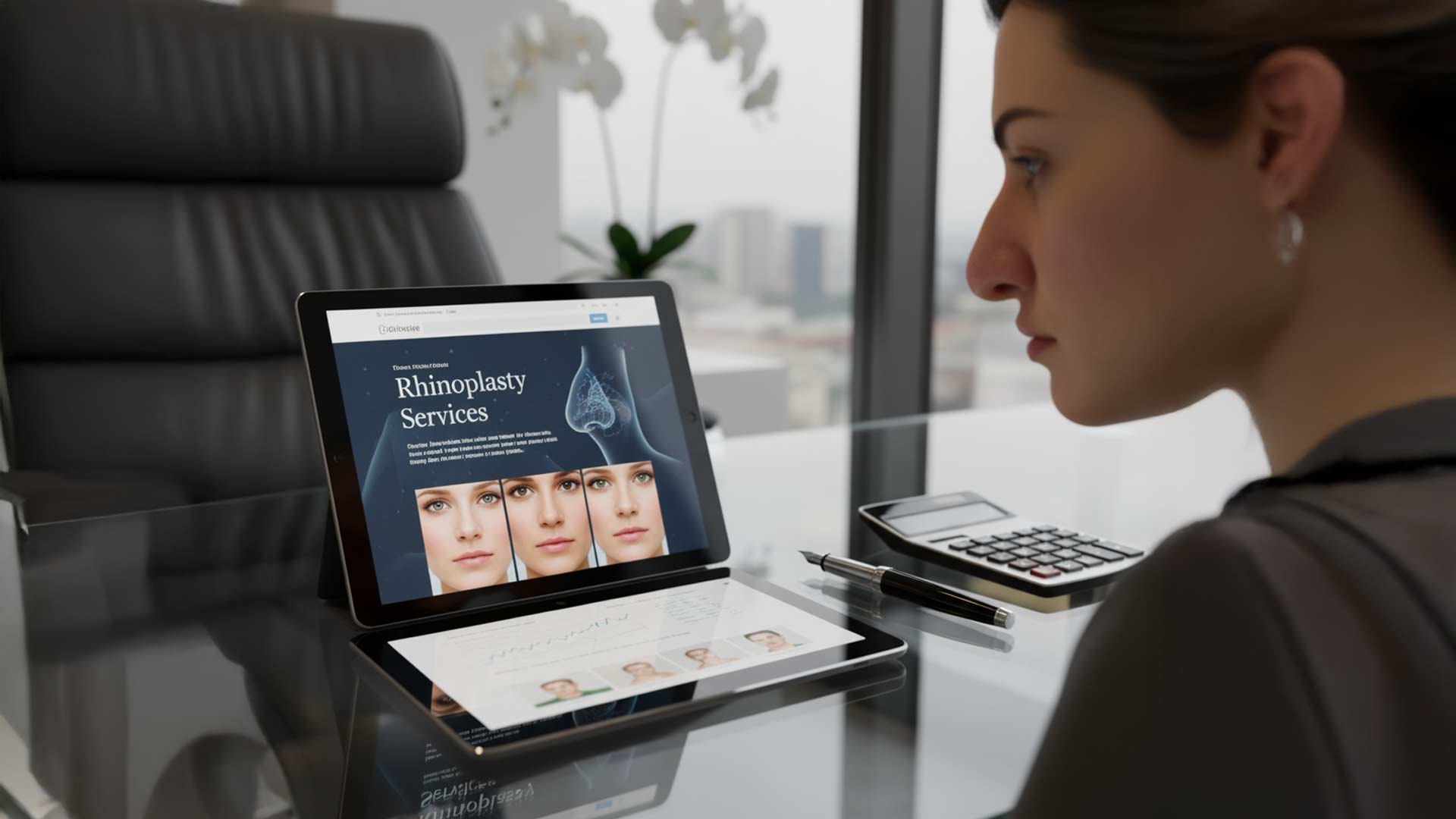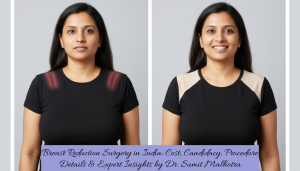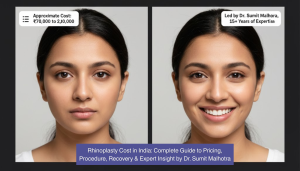The nose is one of the most defining features of your face — it influences your overall appearance, balance, and even confidence. For those who are unhappy with the shape, size, or function of their nose, rhinoplasty offers a life-changing solution.
But what exactly does rhinoplasty involve? How much does it cost in 2025? And what can you expect during recovery?
To answer all your questions, this complete guide draws insights from Dr. Sumit Malhotra, a board-certified plastic and reconstructive surgeon in Lucknow with years of experience performing cosmetic procedures, including advanced rhinoplasty.
1. What Is Rhinoplasty?
Rhinoplasty, commonly known as a nose job, is a surgical procedure designed to reshape or reconstruct the nose. It can enhance facial aesthetics, improve breathing, or correct congenital deformities and injuries.
Depending on your goals, rhinoplasty can:
- Reduce or increase the size of the nose
- Change the nasal bridge or tip shape
- Narrow the nostrils
- Straighten a crooked nose
- Correct breathing issues from a deviated septum (functional rhinoplasty)
Dr. Sumit Malhotra explains:
“Rhinoplasty is both an art and a science. It requires surgical precision and an artistic eye to create balance that complements the patient’s unique facial features.”
2. Types of Rhinoplasty Procedures
There isn’t just one kind of rhinoplasty — several types are tailored to different goals.
a. Cosmetic Rhinoplasty
Performed primarily to enhance appearance by refining the shape, symmetry, or size of the nose.
b. Functional Rhinoplasty
Aimed at correcting breathing difficulties caused by structural issues such as a deviated septum or nasal valve collapse.
c. Revision Rhinoplasty
Done when a patient needs corrections or improvements from a previous nose surgery.
d. Non-Surgical Rhinoplasty (Liquid Nose Job)
Uses dermal fillers to temporarily reshape the nose without surgery. It’s ideal for mild bumps or asymmetry, but not for major structural changes.
According to Dr. Malhotra:
“Surgical rhinoplasty offers long-lasting results and better control over both structure and aesthetics. Non-surgical methods are suitable for minor improvements but are temporary.”
3. The Rhinoplasty Consultation Process
Before any surgery, a detailed consultation is essential. Dr. Sumit Malhotra’s process in Lucknow involves:
- Facial assessment and digital imaging to visualize potential outcomes.
- Discussion of expectations — both cosmetic and functional.
- Medical evaluation to ensure patient safety.
- Customized surgical plan tailored to facial harmony.
This stage helps align realistic expectations with surgical possibilities, which is critical for patient satisfaction.
4. The Rhinoplasty Procedure — Step by Step
While each case is unique, most rhinoplasties follow a similar structure.
Step 1: Anesthesia
Performed under local or general anesthesia depending on complexity.
Step 2: Incision Type
Two main approaches exist:
- Closed Rhinoplasty: Incisions inside the nostrils; no visible scars.
- Open Rhinoplasty: Small incision across the columella (the strip between nostrils) allowing better access for detailed reshaping.
Step 3: Reshaping the Nose
Cartilage or bone is sculpted to achieve the desired structure. Sometimes, grafts from the septum or ear are used for support.
Step 4: Closing and Recovery
Once reshaped, incisions are closed, and nasal splints are applied to maintain structure during healing.
Dr. Malhotra notes:
“Precision is key — the nose must look natural and function normally. A well-done rhinoplasty should enhance beauty without appearing ‘done’.”
5. Rhinoplasty Cost in 2025 (India and Lucknow Overview)
The cost of rhinoplasty in India in 2025 varies based on several factors: surgeon expertise, technique, and surgical complexity.
Here’s a general breakdown:
| Type of Rhinoplasty | Approx. Cost (INR) |
| Primary Rhinoplasty (Cosmetic) | ₹90,000 – ₹2,50,000 |
| Functional Rhinoplasty (Septoplasty + Aesthetic) | ₹1,20,000 – ₹2,80,000 |
| Revision Rhinoplasty | ₹1,50,000 – ₹3,50,000 |
| Non-Surgical (Fillers) | ₹25,000 – ₹60,000 |
In Lucknow, the average rhinoplasty cost in 2025 ranges between ₹1,00,000 and ₹2,50,000, depending on the hospital facilities and surgeon’s experience.
Dr. Sumit Malhotra emphasizes transparency:
“Each patient’s anatomy and goals differ — that’s why we provide personalized quotes after consultation rather than fixed package pricing.”
6. Factors Affecting Rhinoplasty Cost
Several elements determine final costs:
- Surgeon’s Experience – Experienced surgeons like Dr. Malhotra ensure precision and safety, influencing professional fees.
- Hospital or Facility Charges – Accredited surgical centers provide advanced safety standards, adding to total cost.
- Anesthesia Fees – General anesthesia for complex surgeries costs more than local anesthesia.
- Extent of Correction – Simple tip correction costs less than full structural reconstruction.
- Post-Surgery Care – Follow-ups, medications, and dressings may add 10–15% to the total.
7. Rhinoplasty Recovery Timeline
Recovery from rhinoplasty is gradual but manageable with proper care.
Week 1:
- Splint and bandages are removed.
- Mild swelling and bruising subside.
Weeks 2–4:
- Resume light activities; avoid strenuous exercise.
- Most bruising fades; you can return to work.
Months 2–3:
- Nose shape refines as swelling continues to reduce.
Months 6–12:
- Final contour becomes visible; nasal tissues fully settle.
Dr. Sumit Malhotra advises:
“Patience is essential. The final result can take months, but steady improvements begin within a few weeks. Following post-operative guidelines ensures smooth recovery and natural results.”
8. Post-Operative Care and Tips
After rhinoplasty, following recovery instructions is critical.
Do’s:
- Sleep with your head elevated.
- Use prescribed cold compresses to reduce swelling.
- Take antibiotics and pain medication as prescribed.
- Attend all follow-up appointments.
Don’ts:
- Avoid glasses for the first few weeks (they can press on healing cartilage).
- Refrain from strenuous exercise.
- Avoid blowing your nose forcefully.
- Stay out of the sun to prevent discoloration.
9. Are Rhinoplasty Results Permanent?
Yes, surgical rhinoplasty results are long-lasting and often permanent, as bone and cartilage are structurally modified. However, minor changes can occur over years due to aging or tissue remodeling.
Non-surgical rhinoplasty using fillers typically lasts 9–18 months and requires maintenance.
Dr. Malhotra notes:
“When performed correctly, rhinoplasty results last a lifetime. The goal is harmony — a natural nose that suits your face, not an artificial one.”
10. Potential Risks and Complications
Like any surgical procedure, rhinoplasty carries potential risks such as swelling, infection, or asymmetry. These are rare when performed by a skilled surgeon.
Patients can minimize risks by choosing a qualified, board-certified plastic surgeon with extensive experience — such as Dr. Sumit Malhotra in Lucknow — and by following post-surgery care diligently.
11. Who Is a Good Candidate for Rhinoplasty?
Ideal candidates include individuals who:
- Are over 18 years old (nasal growth completed).
- Are in good general health.
- Have realistic expectations.
- Seek improvement, not perfection.
Dr. Malhotra explains:
“Good candidates are those who understand that rhinoplasty enhances features — it doesn’t create a completely new face.”
12. Functional Benefits: Breathing Easier After Surgery
Beyond cosmetic improvement, rhinoplasty can also have functional benefits.
Patients suffering from deviated septum, nasal blockage, or chronic sinus issues often experience dramatic relief after combined functional rhinoplasty and septoplasty.
Dr. Malhotra adds:
“When form and function align, the result is not only aesthetic harmony but better quality of life. Breathing comfortably is as rewarding as looking better.”
13. Rhinoplasty Before and After Expectations
Post-surgery, expect your new nose to appear swollen initially. As swelling subsides, the true refinement becomes visible.
Final results should look balanced and proportional to your facial features — never artificial or exaggerated.
Patients of Dr. Malhotra often report improved self-confidence and facial symmetry that feels authentic and natural.
14. Why Choose Dr. Sumit Malhotra for Rhinoplasty in Lucknow
Choosing the right surgeon is the most critical decision in rhinoplasty.
Dr. Sumit Malhotra is known for his:
- Extensive experience in both cosmetic and reconstructive nasal surgeries.
- Detailed preoperative planning and 3D imaging techniques.
- Patient-centered approach and natural aesthetic sense.
- Proven track record of safe, successful results in Lucknow.
His philosophy is simple:
“The best rhinoplasty is one that no one can tell was done — it should look completely natural.”
15. FAQs About Rhinoplasty
Q1: Is rhinoplasty painful?
Mild discomfort and pressure are normal, but pain is minimal and easily managed with medication.
Q2: How long should I take off work?
Most patients can resume normal activities within 7–10 days, depending on healing.
Q3: Will there be visible scars?
Closed rhinoplasty leaves no visible scars. Open rhinoplasty scars are tiny and fade over time.
Q4: Can rhinoplasty fix breathing problems?
Yes. Functional rhinoplasty corrects structural issues and improves airflow.
Q5: Is the procedure safe?
Yes, when performed by a qualified surgeon in a certified facility.
16. Conclusion: A Confident New You
Rhinoplasty is more than just reshaping your nose — it’s about restoring balance, confidence, and harmony to your entire face.
When performed by an expert like Dr. Sumit Malhotra, an experienced plastic surgeon in Lucknow, the results are natural, proportionate, and life-enhancing.
Whether you’re seeking cosmetic refinement or improved breathing, rhinoplasty can be your step toward both beauty and well-being.
As Dr. Malhotra says:
“The goal isn’t to create a perfect nose — it’s to create your perfect nose, one that complements who you already are.”





